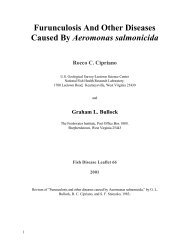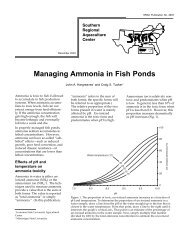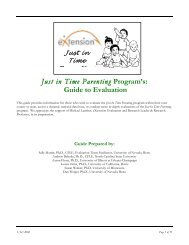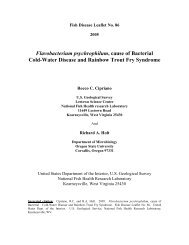A Practical Guide to Nutrition, Feeds, and ... - cop.eXtension.org
A Practical Guide to Nutrition, Feeds, and ... - cop.eXtension.org
A Practical Guide to Nutrition, Feeds, and ... - cop.eXtension.org
You also want an ePaper? Increase the reach of your titles
YUMPU automatically turns print PDFs into web optimized ePapers that Google loves.
Receiving <strong>and</strong> S<strong>to</strong>rage<br />
<strong>Feeds</strong>tuffs <strong>and</strong> other ingredients are received at the<br />
mill by rail or truck. Rail is generally more economical.<br />
<strong>Feeds</strong>tuffs are unloaded from the railcars or trucks <strong>and</strong><br />
transferred <strong>to</strong> s<strong>to</strong>rage houses or bins. As feedstuffs are<br />
needed, they are moved by belt conveyers or screw<br />
conveyers <strong>to</strong> the appropriate section of the feed mill for<br />
processing.<br />
Grinding, Batching, <strong>and</strong> Mixing<br />
Whole grains (corn, wheat, etc.) are ground<br />
through a number-7 screen in a hammer mill before<br />
batching <strong>and</strong> mixing. During batching, feed ingredients<br />
are conveyed <strong>to</strong> a hopper above the mixer <strong>and</strong> weighed<br />
before mixing. After batching, the ingredients are<br />
dropped in<strong>to</strong> a mixer <strong>and</strong> mixed for a predetermined<br />
time (usually 1–2 minutes). When mixing has been<br />
completed, feed mixture is reground through a smaller<br />
screen — a number 4 or 6 depending on the type of<br />
feed being manufactured — <strong>and</strong> moved in<strong>to</strong> hoppers<br />
above the extruders or the pellet mill.<br />
Steam Pelleting<br />
Steam-pelleted (sinking) feeds are manufactured<br />
by using moisture, heat, <strong>and</strong> pressure <strong>to</strong> form ground<br />
feed ingredients in<strong>to</strong> larger homogenous feed particles.<br />
Steam is added <strong>to</strong> the ground feed ingredients <strong>to</strong><br />
increase the moisture level <strong>to</strong> 14–15% <strong>and</strong> temperature<br />
<strong>to</strong> 160–185ºF. Steam helps <strong>to</strong> gelatinize starch, which<br />
binds the feed particles <strong>to</strong>gether. The hot “mash” is then<br />
forced through a pellet die in a pellet mill. Die size is<br />
dependent on the size of pellet desired. The pellets exit<br />
the die at about 14–15% moisture <strong>and</strong> at a temperature<br />
about 10ºF above the temperature of the incoming<br />
mash. Pellets coming from the pellet mill are fragile<br />
<strong>and</strong> must be immediately cooled <strong>and</strong> dried in the pellet<br />
cooler.<br />
Steam-pelleted feeds are generally less expensive<br />
<strong>to</strong> manufacture than extruded feeds because less energy<br />
is expended in their manufacture. In addition, less<br />
destruction of nutrients occurs during steam pelleting<br />
as compared with extrusion. A typical steam-pelleted<br />
feed is shown in Figure 4.<br />
Figure 4. Examples of various feed types: <strong>to</strong>p left, meal-type feed <strong>to</strong> feed fry<br />
s<strong>to</strong>cked in nursery ponds; <strong>to</strong>p middle, crumbled feed; <strong>to</strong>p right, extruded (floating)<br />
fingerling feed; bot<strong>to</strong>m left, extruded (floating) food-fish feed; <strong>and</strong> bot<strong>to</strong>m<br />
right, steam-pelleted (sinking) feed.<br />
Mississippi Agricultural <strong>and</strong> Forestry Experiment Station 25






